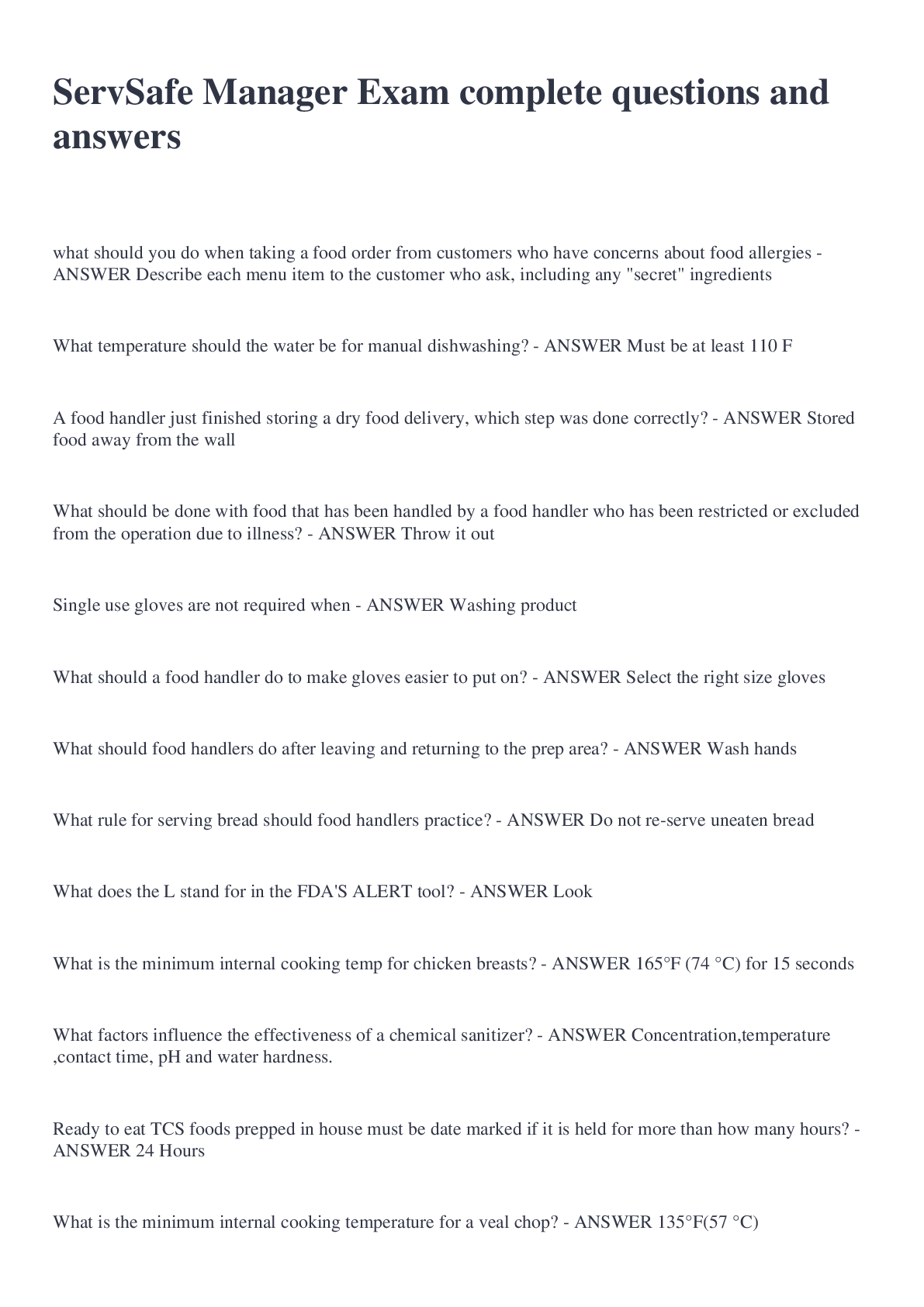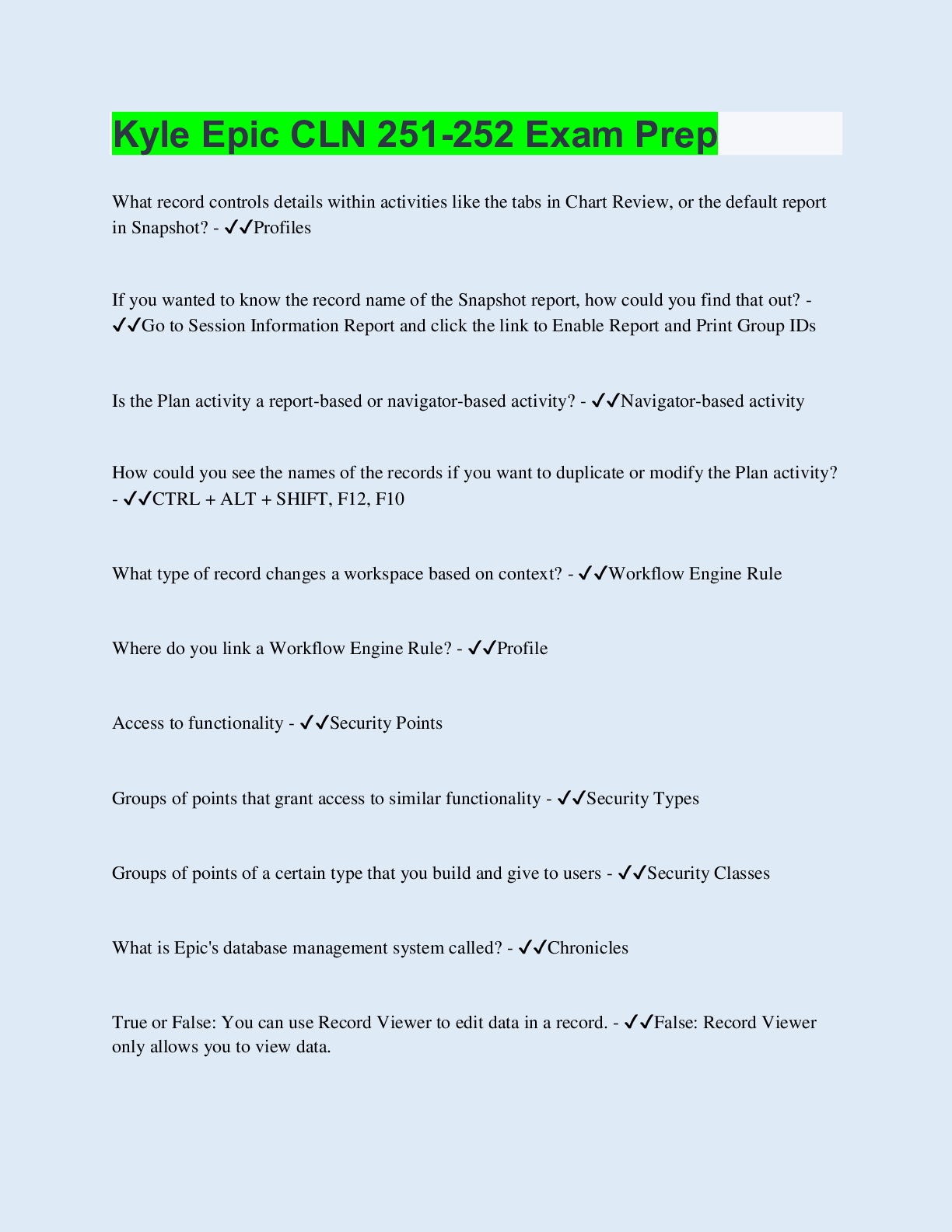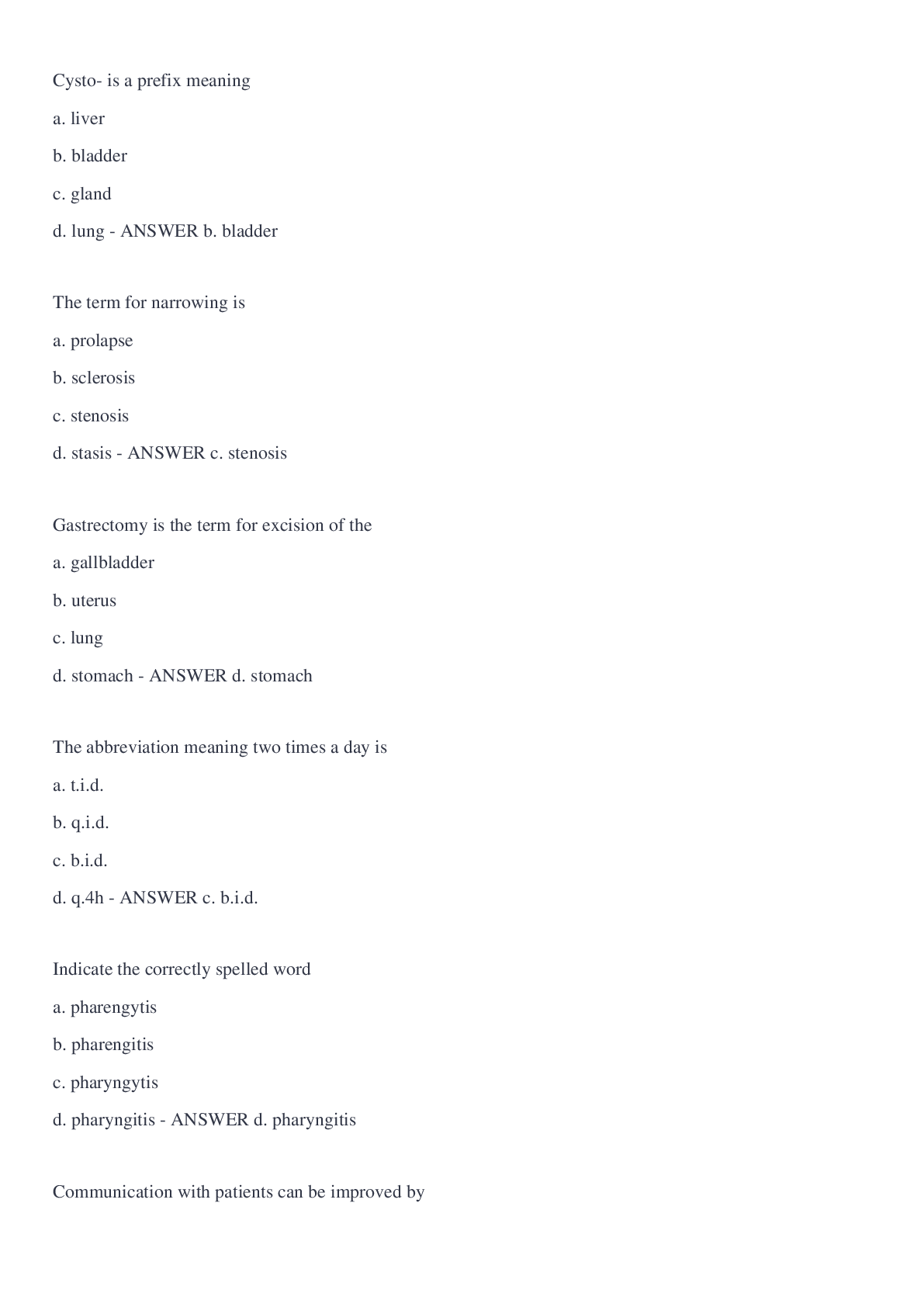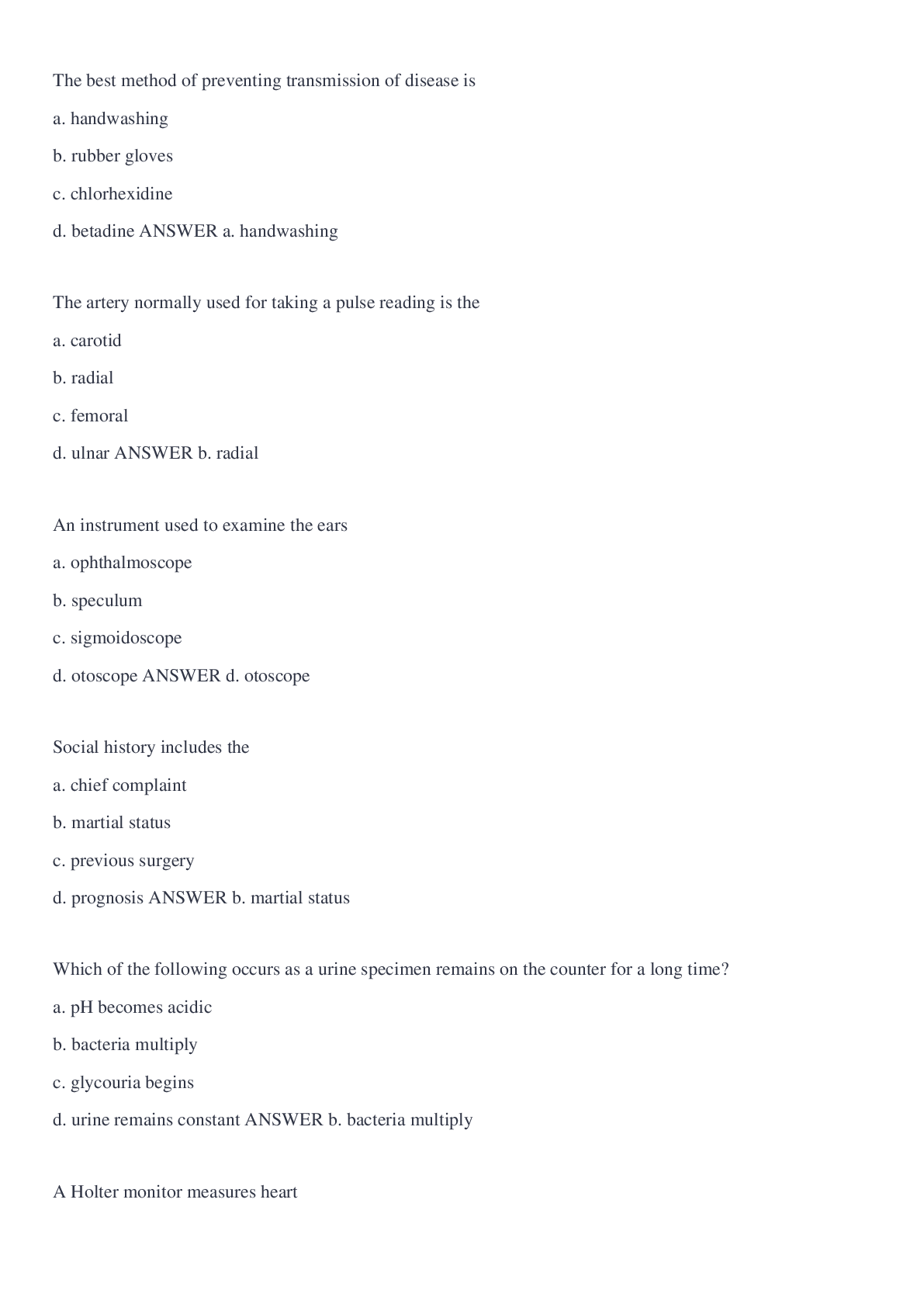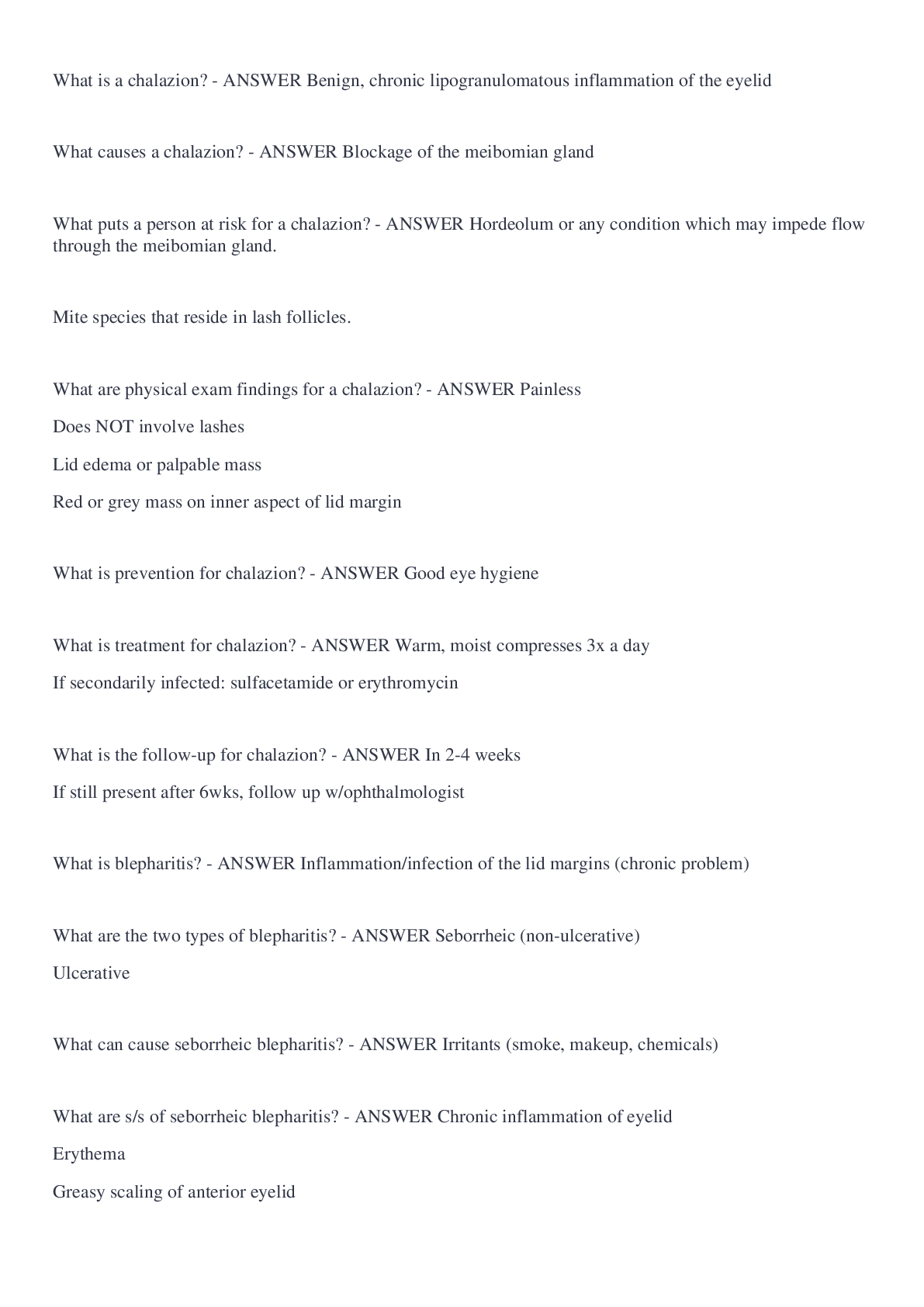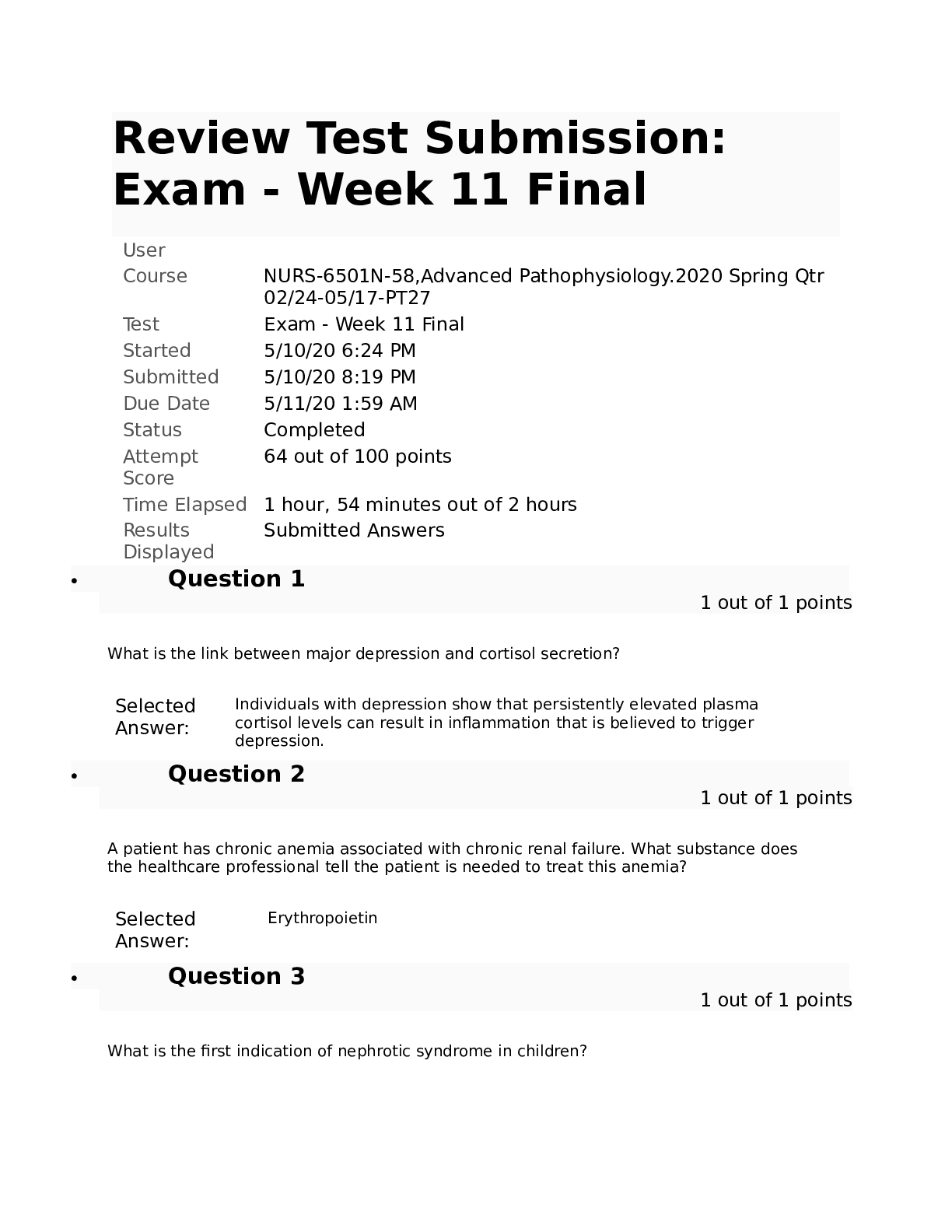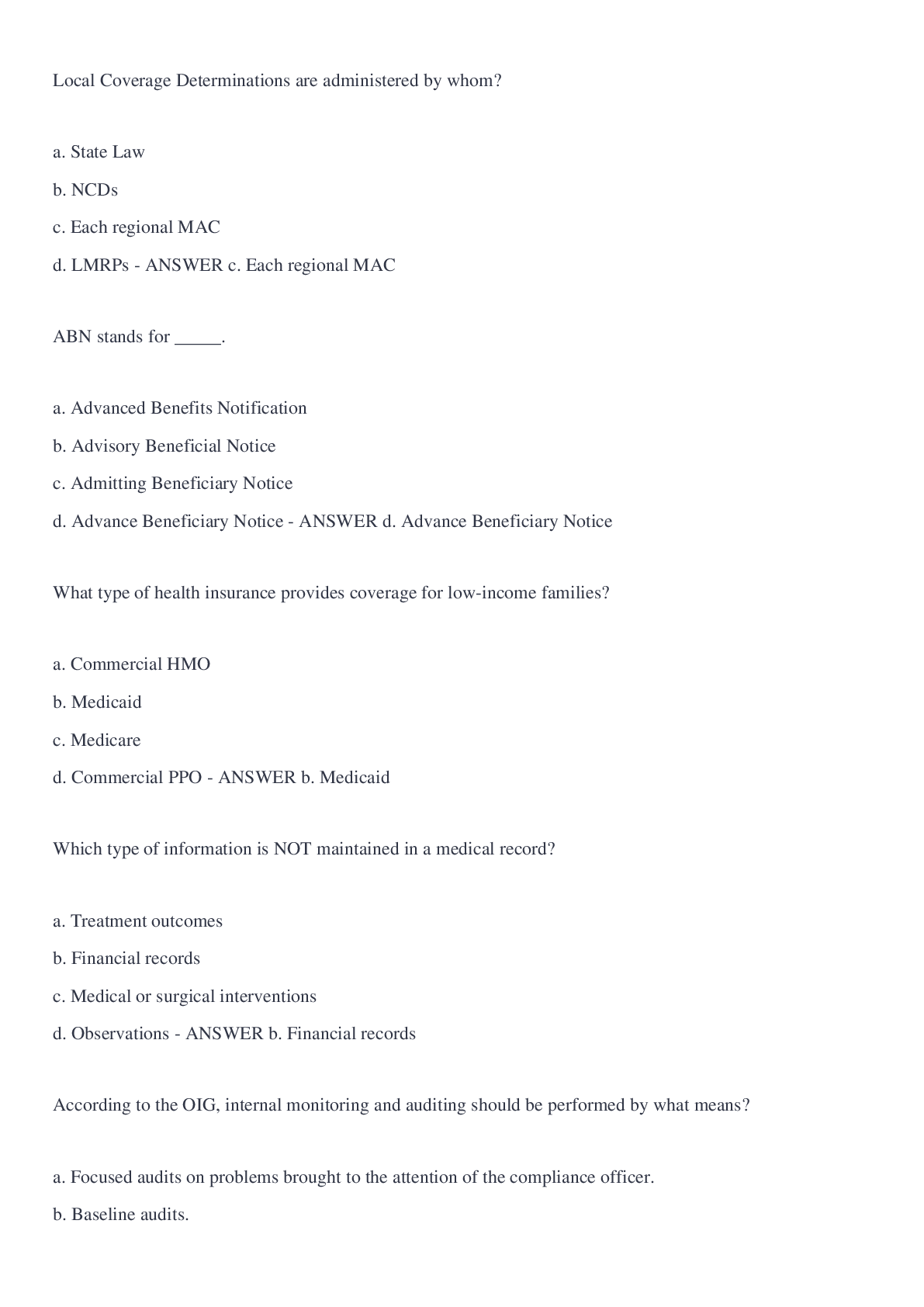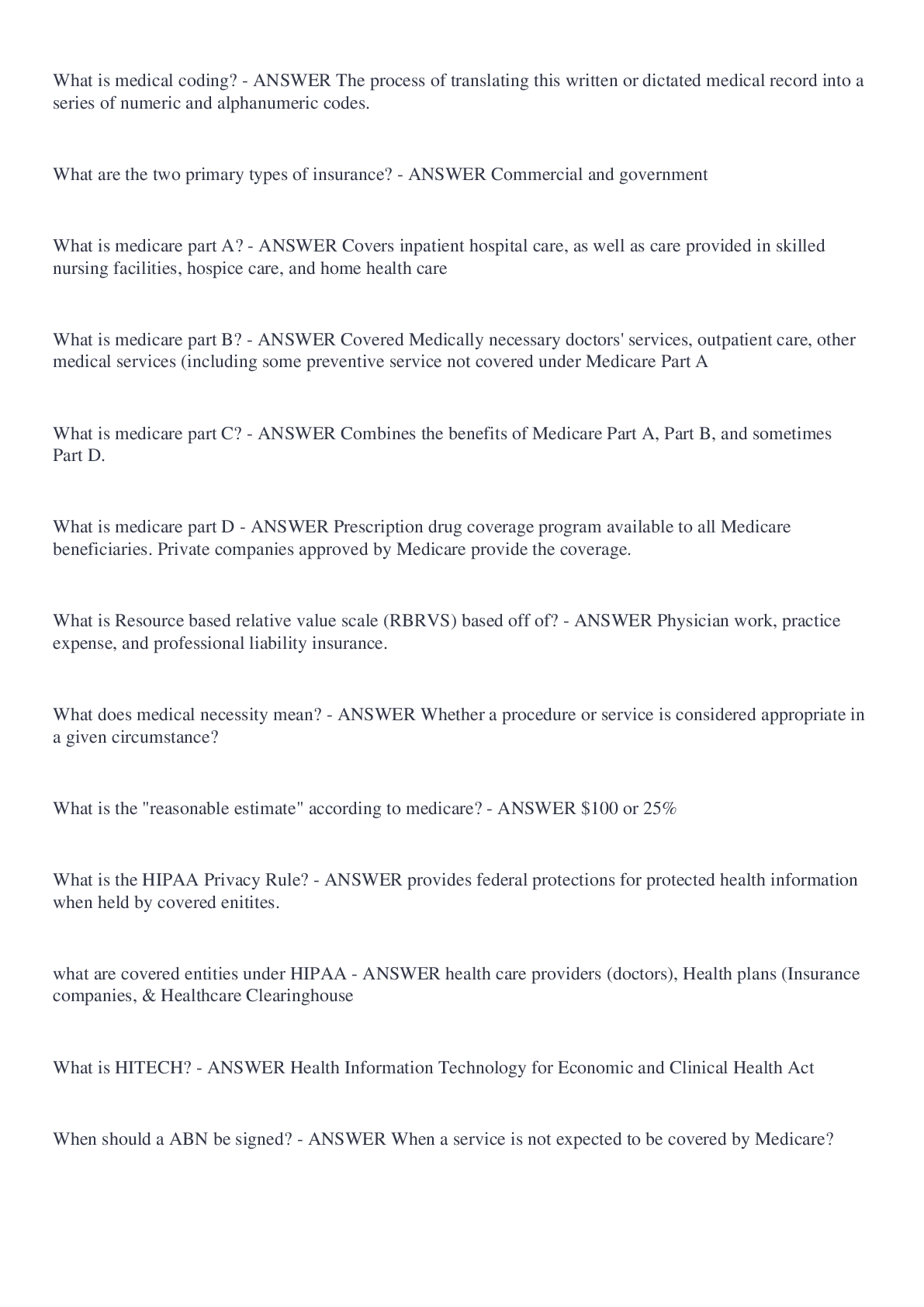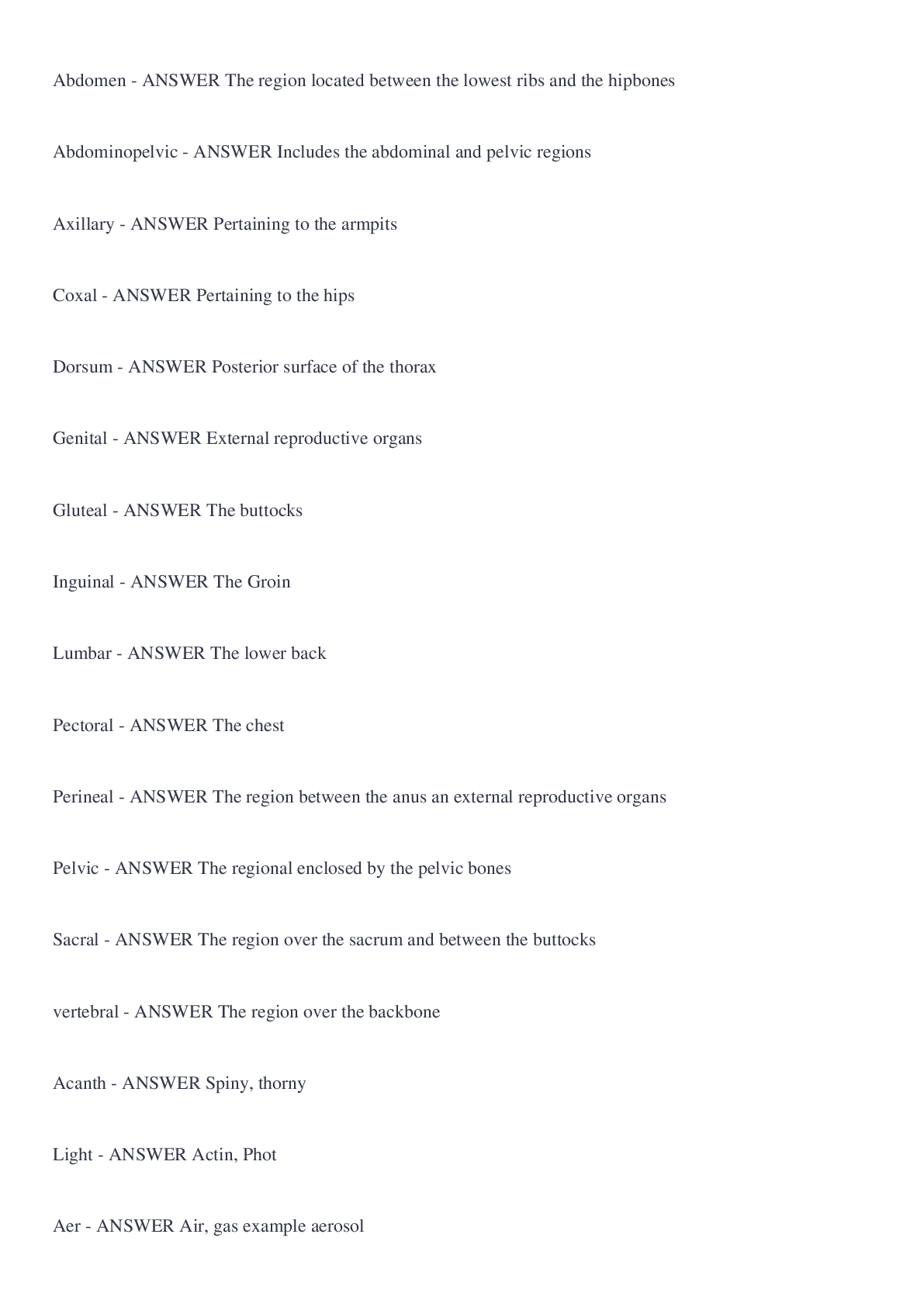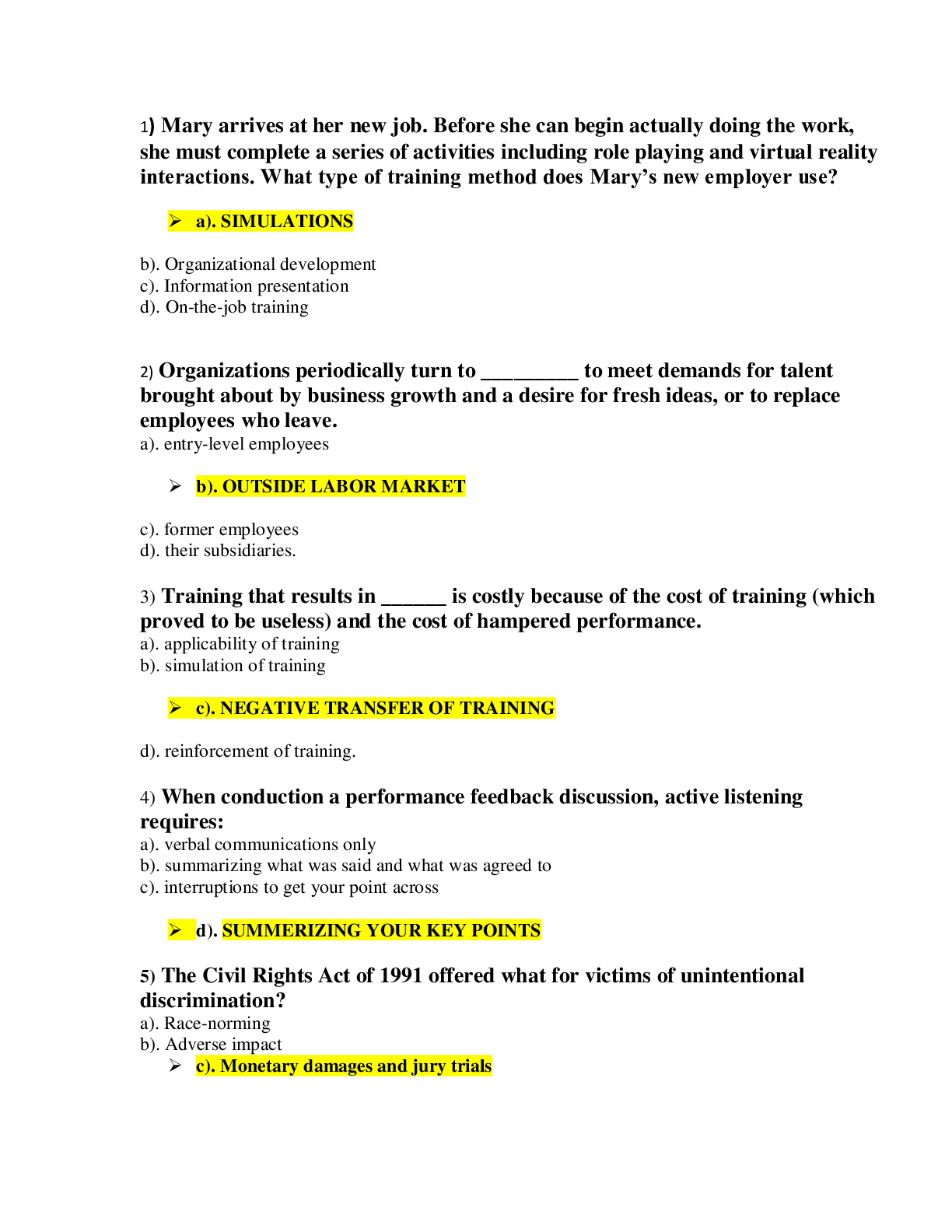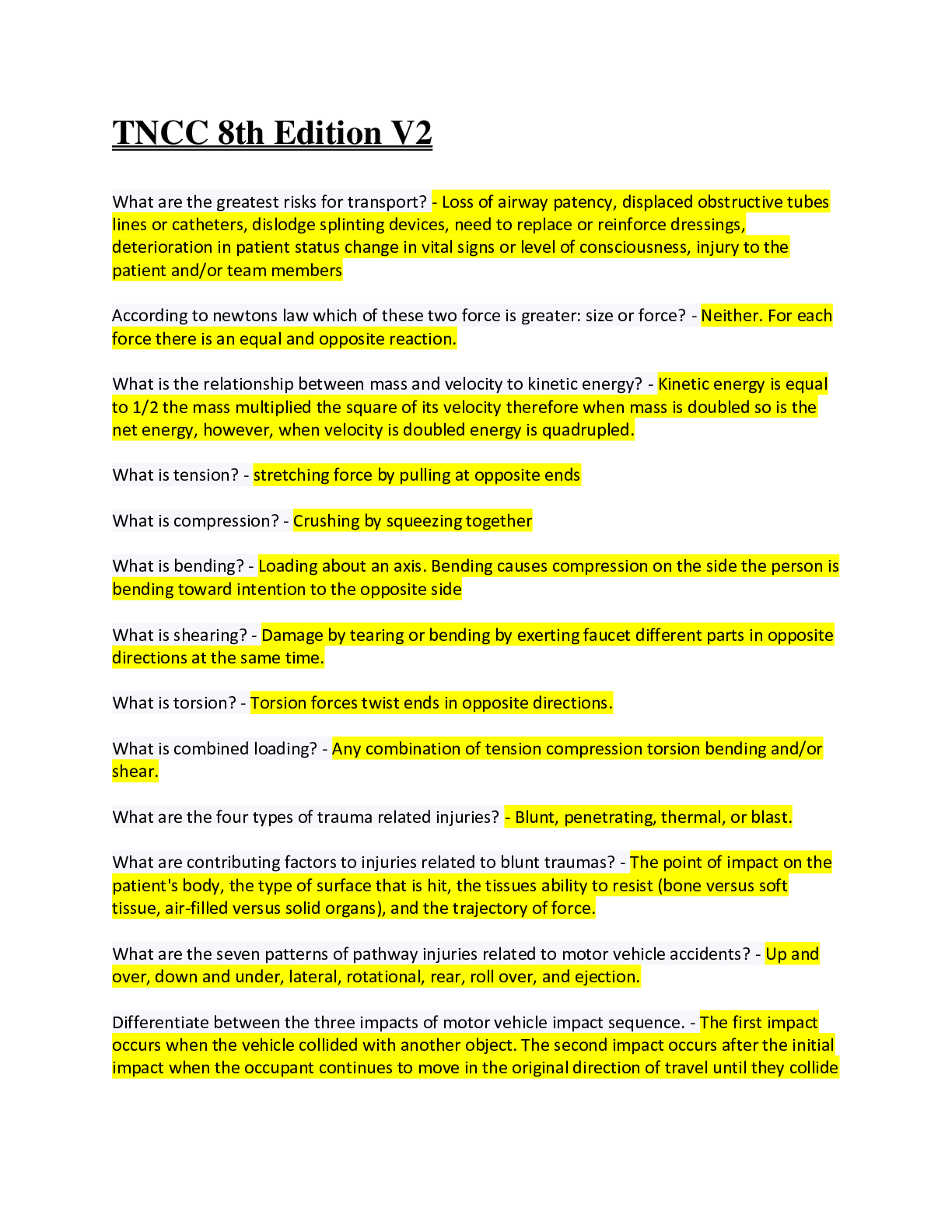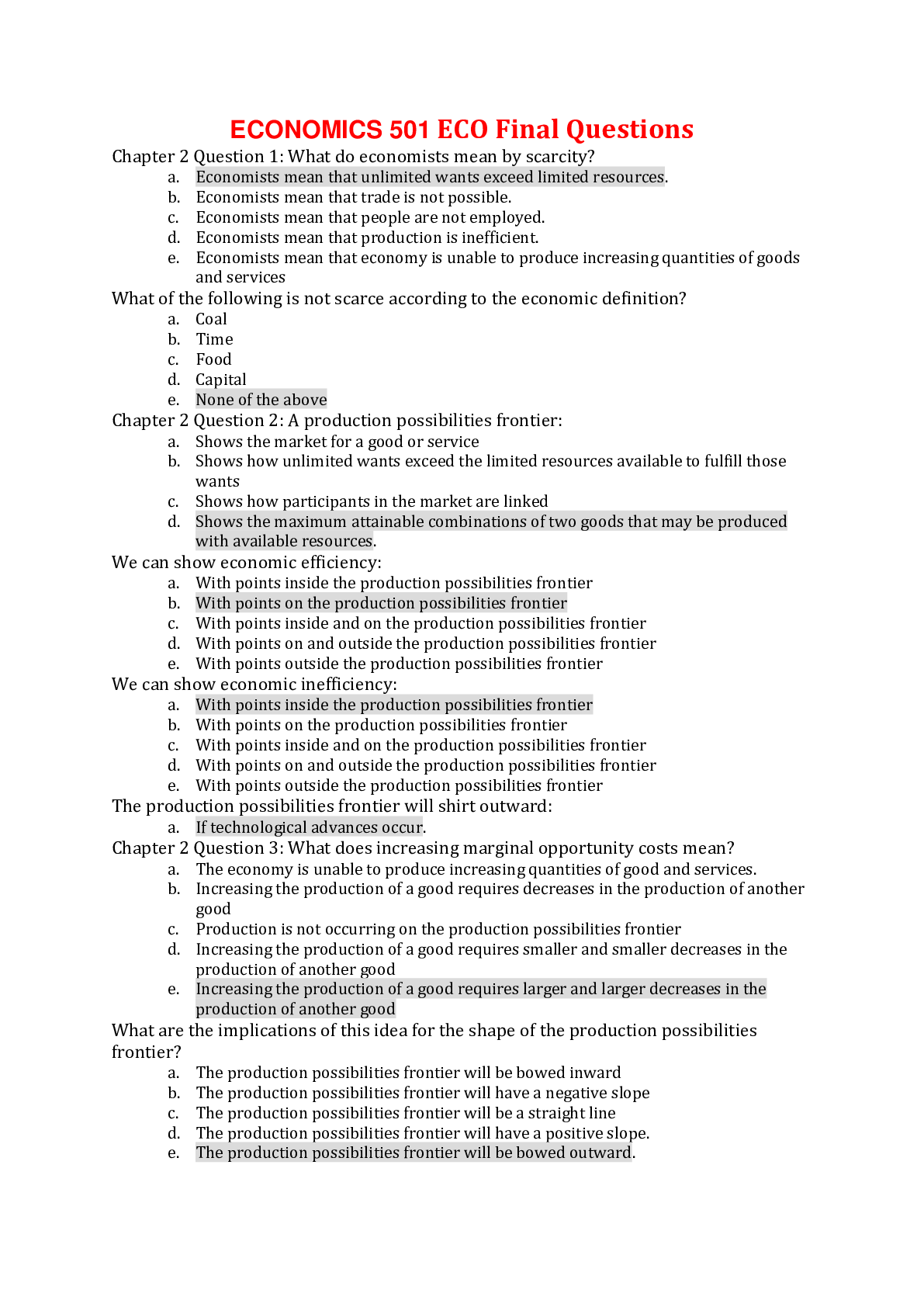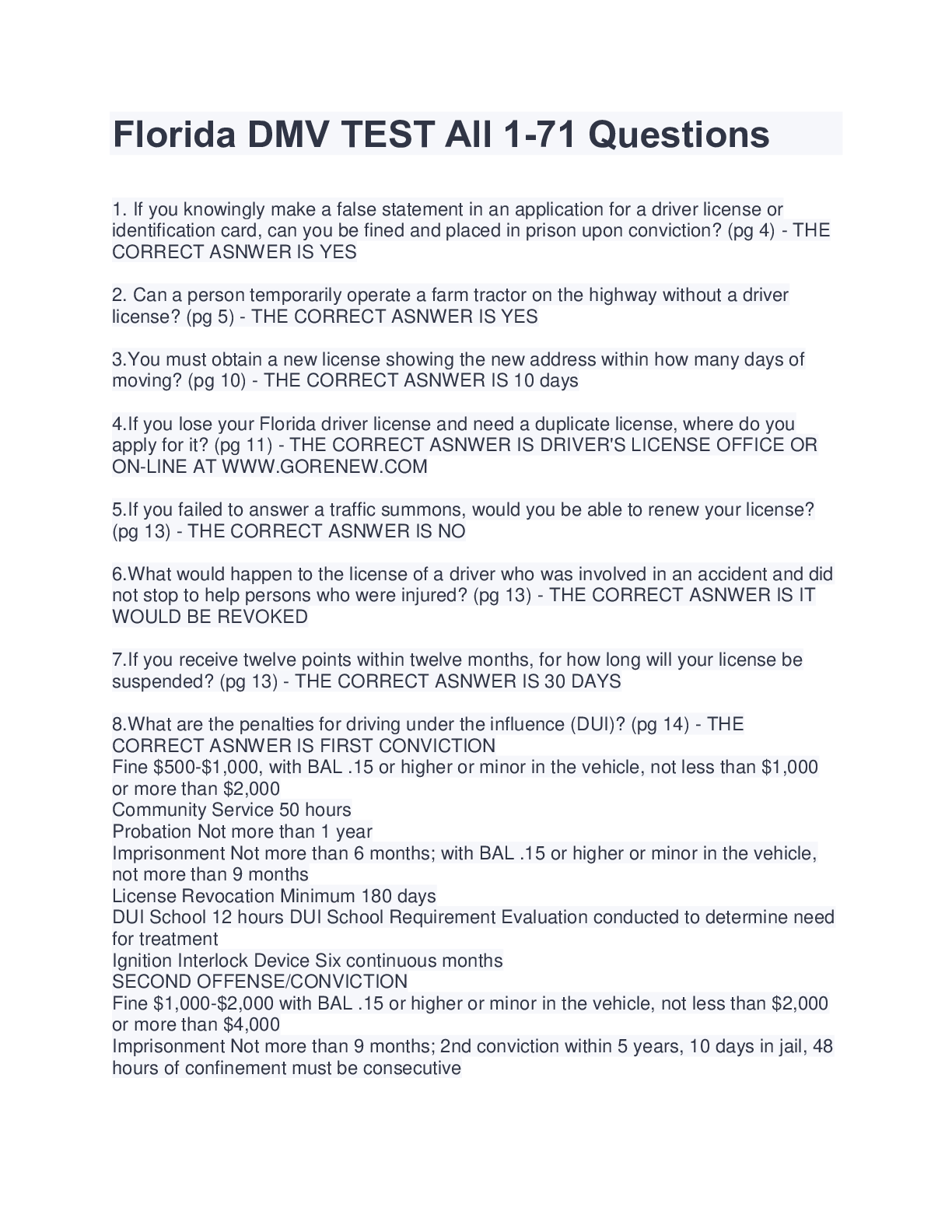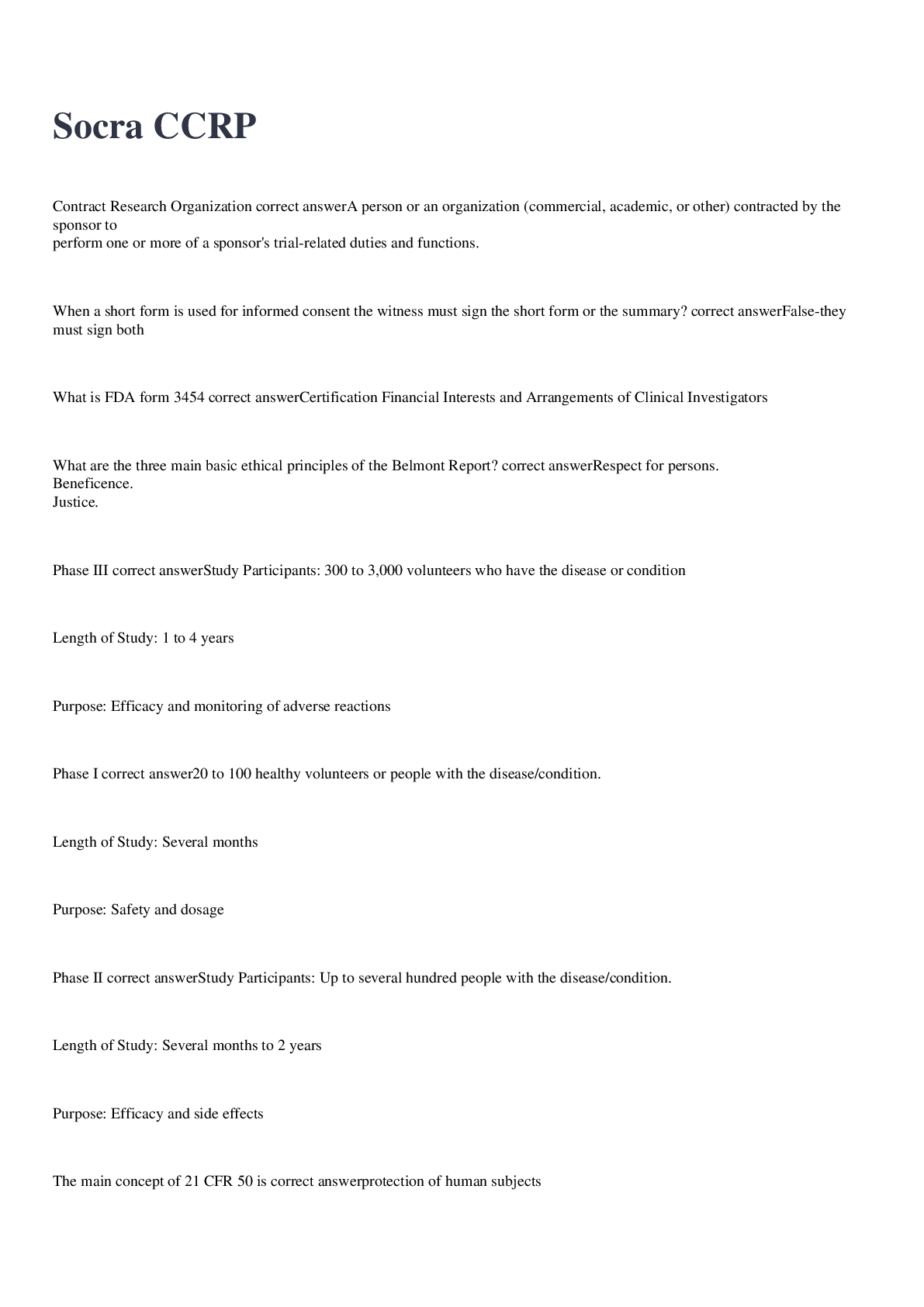Human Resource Management > EXAM > WGU-C232 Introduction to Human Resource Management Graded A+ (All)
WGU-C232 Introduction to Human Resource Management Graded A+
Document Content and Description Below
What Is An Implied Contract? - ANSWER Promise based on an employer's words or actions BFOQ - ANSWER Bona fide occupational qualifications are employment qualifications that employers are permitted ... to consider while making decisions about hiring and retaining employees. However, consideration of these qualities in any other contexts might be deemed discriminatory Affirmative Action - ANSWER Affirmative action is any action taken by an employer to overcome discriminatory effects of past or current practices or policies that create barriers to equal employment opportunity. Affordable Care Act (ACA) - ANSWER A federal law passed in 2010, which prohibits insurers from denying coverage to individuals with pre-existing conditions, sets minimum standards for health insurance policies, includes an individual mandate for individuals to have a health insurance policy, and expands Medicaid eligibility for many individuals and families. Age Discrimination - ANSWER The denial of rights or privileges or other unfair treatment of someone (an applicant or employee) because of age. Age Discrimination in Employment Act of 1967 (ADEA) - ANSWER A federal law that protects workers age 40 and older from employment discrimination based on their age. Americans with Disabilities Act of 1990 (ADA) - ANSWER A federal law that prohibits discrimination on the basis of disability. The ADA ensures equal opportunity for individuals with disabilities in all aspects of employment as well as in other public services. Application - ANSWER A screening instrument that gathers a large amount of applicant biographical and vocational information for relatively little cost. Baby Boomers - ANSWER People born between 1946 and 1964; in general, they greatly value loyalty, financial security, stability, and a positive work ethic. Background Checks - ANSWER Used to verify job-related requirements of the applicant, background checks include reviewing items such as driving record, criminal record, credit history, and academic records. Business Ethics - ANSWER The values and principles that are used to evaluate whether the collective behavior of an organization's members is appropriate. Cash Plan - ANSWER Provides for payment of profit shares at regular intervals. Civil Rights Act of 1964 - ANSWER Comprehensive civil rights legislation, signed into law by President Lyndon B. Johnson, which prohibits employment discrimination on the basis of race, color, religion, sex, or national origin. Civil Rights Act of 1991 - ANSWER This Act allows for compensatory and punitive damages for violations of Title VII. Civil Rights Acts of 1866, 1870, and 1871 - ANSWER These acts prohibit employers from discriminating against minorities. Content Validity - ANSWER Method used to confirm that a selection test measures what it is intended to measure by comparing the test to the job description (knowledge, skills, and abilities required to complete a job). Correlation Coefficient - ANSWER The correlation coefficient reflects the stability of a test over time—the higher the coefficient of stability, the more reliable the measure. Culture - ANSWER A culture represents an organization's value system. It includes factors such as employees' willingness to work, their ethics, how the organization thinks they should be treated, and so on. Reliability - ANSWER The consistency or stability of a selection instrument Validity - ANSWER How accurately and precisely a measure assesses an attribute; it assumes the appropriateness of using a given measuring device for drawing inferences about the criteria Demand - ANSWER The number and types of employees you will need to achieve the organization's strategic mission Supply - ANSWER The number and types of employees who will be available now or in the future to fill the jobs Defined Benefit Plan - ANSWER A retirement plan in which the employer commits (and pays) a specific monthly benefit (or amount) to the employee when the employee retires. Defined Contribution Plan - ANSWER A retirement plan in which the employer pays a specific amount, or contribution, to an employee's retirement during each pay period that the employee is with the firm. Both the traditional 401(k) and Roth 401(k) plans are examples of defined contribution plans. Delphi Technique - ANSWER A method of group decision-making and forecasting that involves successively collating the judgments of experts. Deontological Theories - ANSWER Deontological theories of ethics evaluate the rightness or wrongness of an action based on how well that action conforms to some rule or principle, regardless of the consequences. Developing Data - ANSWER The first phase of the process of human resources planning. Developing data includes inventories of the current workforce, projected future needs, and an understanding of what will be required to meet those needs. Development - ANSWER Activities or actions that help an employee prepare for future jobs. Direct Compensation - ANSWER The money paid directly to employees in exchange for their work, including wages, salaries, bonuses, commissions, and tips. Disability - ANSWER According to the Americans with Disabilities Act, a disability includes: a physical or mental impairment that substantially limits one or more major life activities; a record of such impairment; or being perceived as having such an impairment. Empirical Validity - ANSWER Empirical validity (also called statistical or predictive validity) describes how closely scores on a test correspond (correlate) with behavior as measured in other contexts. Employee Benefits - ANSWER The parts of the total compensation package (other than pay for time worked) provided to employees in whole or in part by employer payments such as life insurance, pension, worker's compensation, and vacation. Rewards are provided by the organization to employees for their membership and/or participation (attendance) in the organization. Employee Referral Programs - ANSWER Word-of-mouth advertisements that generally involve rewarding employees for referring skilled job applicants to an organization. Employee Retirement Income Security Act (ERISA) - ANSWER A federal law that sets minimum standards for pension plans in the private sector. Employment At-will - ANSWER A common-law rule for employment contracts that presume an employer can generally hire, fire, or promote an employee for any reason at any time. In addition, employees can leave for any reason at any time. Equal Employment Opportunity Commission (EEOC) - ANSWER A federal agency created by the Civil Rights Act of 1964, tasked with formal enforcement of employment discrimination law. Equal Pay Act of 1963 (EPA) - ANSWER A federal law requiring that employers provide equal pay for men and women who do similar work in the same workplace. Essential Functions - ANSWER The fundamental job duties of a position. External Environment - ANSWER The factors that organizations and their managers have no control over, such as legislation, changes in technology, competition, and so on. Fair Labor Standards Act of 1938 (FLSA) - ANSWER A federal law that restricts child labor and establishes minimum wage and overtime pay standards for employees. The intent of the law was to "put a floor under wages and a ceiling over hours of work and to abolish abuses of child labor." Forced Distribution Appraisal - ANSWER A performance-evaluation method in which a superior must assign only a certain proportion of subordinates to each of several categories with respect to each other. A common forced-distribution scale may be divided into five categories, with a fixed percentage of all subordinates in a group falling within each of these categories. Gender Discrimination - ANSWER The unfavorable treatment of someone (an applicant or employee) on the basis of their sex. Gender Identity Discrimination - ANSWER Discrimination against an individual because that person is transgender, lesbian, gay, or bisexual. Generation X - ANSWER People born between 1965 and 1980 who are typically well-positioned within their careers and find value in organizations that are stable, provide flexibility to define work arrangements (such as telecommuting), offer child care and elder care benefits, and promote work/life balance that allows employees to enjoy life now instead of waiting for retirement. Genetic Information Nondiscrimination Act of 2008 (GINA) - ANSWER A federal law that prohibits the use of genetic information in employment decisions and restricts employers from requesting, requiring, or purchasing genetic information. Givebacks - ANSWER A reduction in employee wages or benefits conceded by a labor union in exchange for other benefits or in recognition of unfavorable economic conditions. HR - ANSWER Abbreviation for Human Resources, often referring to the department charged with overseeing an organization's personnel or human resources. HR Generalists - ANSWER HR generalists usually provide guidance to employees, support management, and serve as a source of help and information on human resource matters. HR Specialists - ANSWER HR specialists are responsible for specific human resource management functions within an organization, such as recruiting, training, or compensation. HRM - ANSWER Abbreviation for Human Resource Management HRP - ANSWER Abbreviation for Human Resource Planning How Was the EEOC Created? - ANSWER By the Civil Rights Act of 1964 HR Is Influenced By What Four Internal Environment Factors? - ANSWER 1. Culture; shaped by top management values 2. Technology; refers to the firm's equipment and knowledge 3. Organizational structure 4. Organizational size Human Resource Management - ANSWER Human resource management, or HRM, is responsible for the recruitment, selection, training, and motivation of the organization's employees. HRM is therefore concerned with the fundamental task of defining and analyzing jobs in organizations. Human Resource Planning - ANSWER Human resource planning, or HRP, involves forecasting the human resource needs of an organization and planning whatever is necessary to meet those needs. Immigration Reform and Control Act of 1986 (IRCA) - ANSWER A federal law that makes it illegal to hire or recruit illegal immigrants knowingly. Under IRCA, employers may hire only persons who may legally work in the U.S., i.e., citizens and nationals of the U.S. and aliens authorized to work in the U.S. The employer must verify the identity and employment eligibility of anyone to be hired, which includes completing the Employment Eligibility Verification Form (I-9). Implied Covenant-of-good-faith-and-fair-dealing Exception - ANSWER An exception to the employment-at-will doctrine stating that each party in an employment relationship has made an implied promise to treat the other in good faith and fairness. Implied-contract Exception - ANSWER An exception to the employment-at-will doctrine stating that a legally binding agreement is created between an employer and employee based on their actions, and not on a formal contract. Indirect Compensation - ANSWER In addition to direct compensation, rewards that employers pay for other employee services such as health insurance benefits, paid time off, retirement plans, education, etc. Internal Environment - ANSWER Factors that organizations control as they interact in the global marketplace, such as culture, product development, and strategy. Job Evaluation - ANSWER Process to determine the relative worth of job-related contributions. Job Posting - ANSWER An open invitation to all employees, through prominent display of notice, to apply for a job vacancy. Job Rotation - ANSWER A job design technique in which employees are moved between two or more jobs in a planned manner. The objective is to expose employees to different experiences and a wider variety of skills for cross-training and enhanced job satisfaction. KSAs - ANSWER KSAs are a person's knowledge, skills, and abilities. Knowledge is a theoretical or practical understanding of a subject. Skills are proficiencies developed through experience. Abilities, more enduring than skills, are qualities that a person has to perform a certain task. Learning Organization - ANSWER An organization that is dedicated to the acquisition or development of knowledge and disseminating that knowledge throughout the organization, with the intent of continually transforming itself to better meet the demands of customers. List the Ways That Human Resource Planning Helps Organizations - ANSWER To consider the organization's future staffing needs and to help execute the organization's business strategy. Managerial Estimates - ANSWER The most common method of estimating HR demand. Managerial estimates are typically made by top management (a top-down approach). Millennials - ANSWER People born between 1980 and 2000, considered to value being recognized for their individual contributions within a team. They generally look for: work that is productive and meaningful—not grunt work; leading-edge, innovative technology that supports their current usage of information sharing; the ability to receive continuing education; the opportunity to voice opinions on workplace situations; and workplace flexibility in scheduling, dress/attire and work arrangements. They are especially resistant to authority due to cynicism regarding managerial decisions. Moral Philosophy - ANSWER The principles, rules, and values that individuals use in deciding what is right or wrong Multiple Linear Regression - ANSWER An extension of simple linear regression analysis. However, in multiple linear regression, instead of relating employment to just one variable, multiple variables are used. Narrative Essay Appraisal - ANSWER Evaluation method in which the rater describes the employee's strengths and weaknesses and suggests methods for improving performance. Nation of Origin Employment Discrimination - ANSWER When an employer commits nation of origin employment discrimination, it makes an unfair or harmful employment decision on the basis of where a person or their ancestors are from, or on the culture or people that a person associates with. Nominal Grouping Technique - ANSWER A group process involving problem identification, solution generation, and decision-making. Older Workers Benefit Protection Act of 1990 (OWBPA) - ANSWER An amendment to the Age Discrimination in Employment Act (ADEA), the OWBPA is intended to safeguard older worker's employee benefits from age discrimination. Orientation - ANSWER The process of introducing the employee to the work environment. Paired Comparison Appraisal - ANSWER A performance-evaluation method in which each employee is compared to every other incumbent, two at a time on a single standard, to determine which is "better." Peer Appraisal - ANSWER Assessment of an employee's performance or future success by his or her work colleagues. Often considered an effective tool when teamwork and participation are part of the organizational culture. Precedents - ANSWER A precedent is a controlling rule, example, or guide established by a judge that provides a framework for other judges to follow in later cases. Predictors - ANSWER The pieces of information obtained from a job candidate that are used to predict how successfully the candidate will perform in a future job. Pregnancy Discrimination Act of 1978 - ANSWER An amendment to Title VII of the Civil Rights Act of 1964, this Act makes it illegal to discriminate against a woman because of pregnancy, childbirth, or related medical conditions. Promotion-within Policy - ANSWER A policy in which the employer states a commitment to consider current employees for new or replacement job opportunities before hiring candidates from outside the organization. Public-policy Exception - ANSWER The public-policy exception is an exception to the employment-at-will doctrine. Under this exception, an employer can not terminate an employee for reasons that would violate public-policy interest or statute. Quality of Work Life - ANSWER The quality of life experienced by employees in their work environments. ROI - ANSWER ROI stands for return on investment, a performance measure of the benefit resulting from an investment of a resource. Race and Color - ANSWER Race and color are protected categories under Title VII of the Civil Rights Act. They include ancestry, physical characteristics, race-associated illnesses, culture, perception of race, skin tone, and so on. Reasonable Accommodation - ANSWER Any change to a job, the work environment, or the way things are customarily done that enables a person with a disability to enjoy equal employment opportunities. Recruiting - ANSWER Recruiting is the set of activities and processes used to obtain sufficient numbers of qualified people so that an organization can select the most appropriate candidates to fill its job needs. Redundancy Planning - ANSWER HR planning associated with the process of laying off employees who are no longer needed. Reference Checks - ANSWER Contacting previous employers of a job applicant to determine his or her job history. Reference checks may also include checking with school(s) or college(s) attended by the applicant to verify educational qualifications. Rehabilitation Act of 1973 - ANSWER A federal law that makes it illegal to discriminate against a qualified person with a disability in the federal government. The Act also authorizes state grants for rehabilitation services to disabled persons. Religious Discrimination - ANSWER Religious discrimination is the unfavorable or unfair treatment of a person on the basis of that person's religious beliefs. Replacement Planning - ANSWER Replacement planning uses charts that show the names of the current occupants of positions in the organization and the names of likely replacements. SWOT Analysis - ANSWER SWOT is an acronym for strengths, weaknesses, opportunities, and threats. The SWOT analysis provides the firm actionable direction for competing in the marketplace. Selection - ANSWER The process of gathering information about job applicants to determine who should be hired for an available position. Simple Linear Regression - ANSWER A projection of future demand is based on a past relationship between the organization's employment level and a variable related to employment, such as sales. A linear regression shows how these measures are connected. Straight Ranking Appraisal - ANSWER A performance-evaluation method in which a superior lists the subordinates in order, from best to worst, usually on the basis of overall performance. Strategy - ANSWER A strategy is the plan an organization has to compete in a marketplace. A strategy can consist of products and services, employees, and the organization's goals, among other things. Strengths - ANSWER Strengths are a company's core competencies, abilities, and capacities that give it an advantage when meeting the needs of target customers. Succession Planning - ANSWER Succession planning tends to be long-term, developmental, and flexible. Although succession planning is widely practiced, many employers who use it tend to emphasize characteristics of the managers and downplay characteristics of the positions to which the managers may eventually be promoted. Technology - ANSWER Technology is the equipment and knowledge used to produce goods and services. The exact meaning of technology varies widely among industries and fields. Threats - ANSWER Threats are conditions, trends, or barriers in the external environment that hinder firm performance. Title VII - ANSWER A part of the Civil Rights Act of 1964 that prohibits employment discrimination on the basis of race, color, religion, sex, or national origin. Total Compensation - ANSWER Sum of all direct compensation (such as salary, bonus, commission) and indirect benefits (such as insurance, paid time off, retirement plans) that an employee receives from an employer. Training - ANSWER Activities or actions directed toward employees' improvement on the current job. Uniformed Services Employment and Re-employment Rights Act (USERRA) - ANSWER A federal law that protects military service members' and veterans' civilian employment rights. Among other things, under certain conditions, USERRA requires employers to put individuals back to work in their civilian jobs after military service. Utilitarian Theories - ANSWER A utilitarian theory of ethics evaluates the rightness or wrongness of an action based on the consequences of that action. [Show More]
Last updated: 1 year ago
Preview 1 out of 20 pages
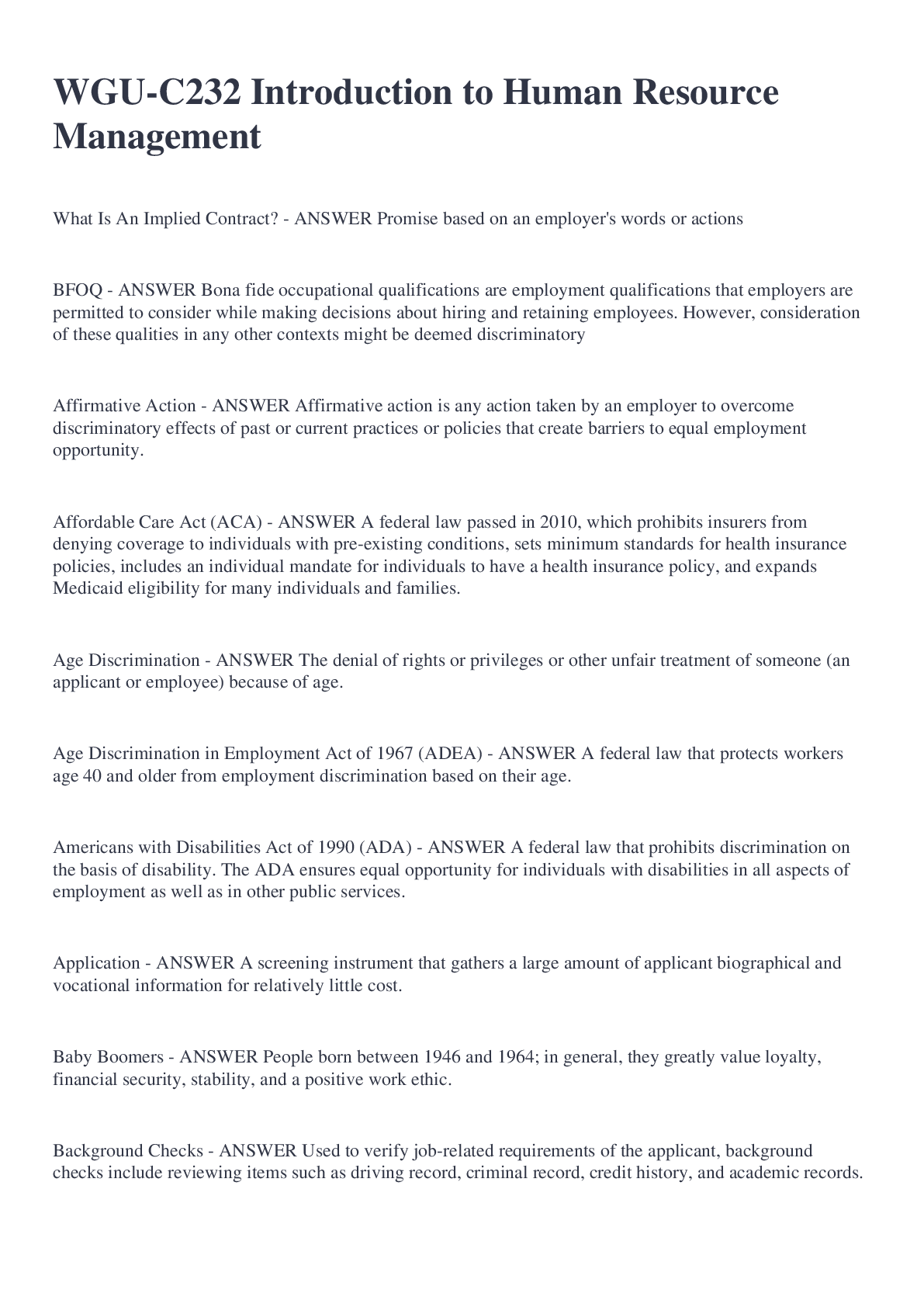
Reviews( 0 )
Document information
Connected school, study & course
About the document
Uploaded On
Nov 04, 2022
Number of pages
20
Written in
Additional information
This document has been written for:
Uploaded
Nov 04, 2022
Downloads
0
Views
37

